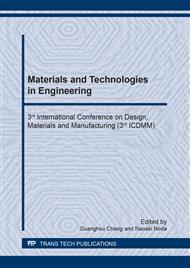p.3
p.8
p.15
p.23
p.28
p.35
p.40
p.46
The Synergistic Effects of Multi-Filler Addition on the Mechanical and Thermo-Mechanical Properties of Phenolic Resins
Abstract:
The effects of the carbon fiber (CF), carbon black (CB) and nanosilica (SiO2) on the mechanical properties of the phenolic resin (PF) were studied and the optimum composition was selected for the preparation of quaternary composites (CF/CB/SiO2 phenolic composites). The incorporation of poly (acrylonitrile-co-butadiene) rubber (NBR) to strengthen the quaternary composites were also studied. The morphological, mechanical and thermo-mechanical properties of unmodified and NBR modified-quaternary phenolic composites were investigated. The phenolic compounds were mixed by ball milling and the phenolic composites were fabricated by hot compression molding. Scanning electron microscopy images of NBR modified-quaternary phenolic composites show the high fracture surface roughness. The results show that the addition of 5 wt% NBR in the quaternary composites offer the highest tensile strength and Young’s modulus which are significantly improved by 176% and 235%, respectively, and they also offer the high flexural strength, impact strength and flexural modulus which are improved by 79%, 29% and 12%, respectively, compared to neat PF. The glass transition temperature (Tg) of unmodified and NBR modified-quaternary phenolic composites are higher than that of neat PF (107.3 °C). The increase of NBR content does not deteriorate Tg of the quaternary phenolic composites. This study provides a new pathway for making advanced phenolic composites.
Info:
Periodical:
Pages:
23-27
Citation:
Online since:
December 2018
Authors:
Price:
Сopyright:
© 2018 Trans Tech Publications Ltd. All Rights Reserved
Share:
Citation:


